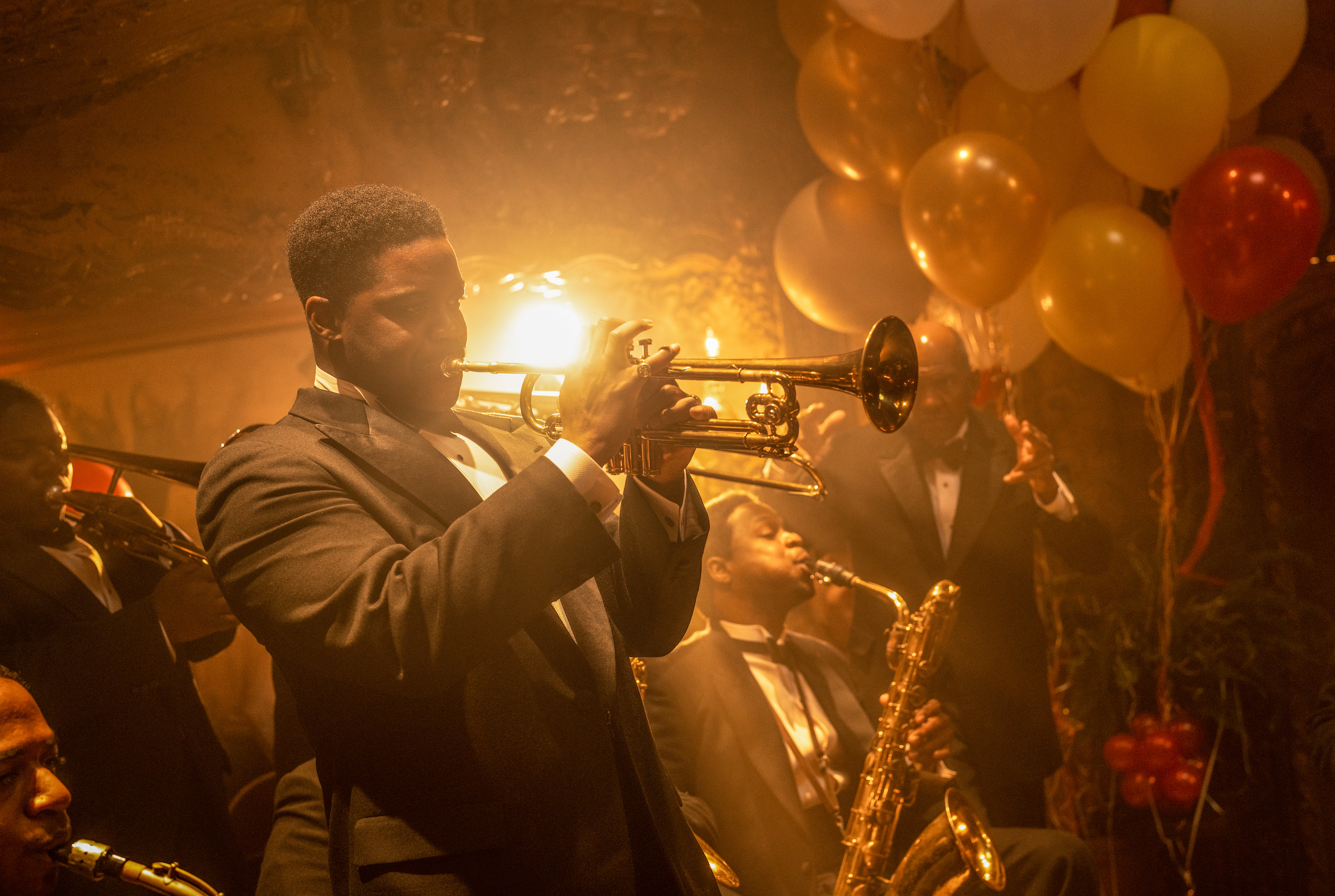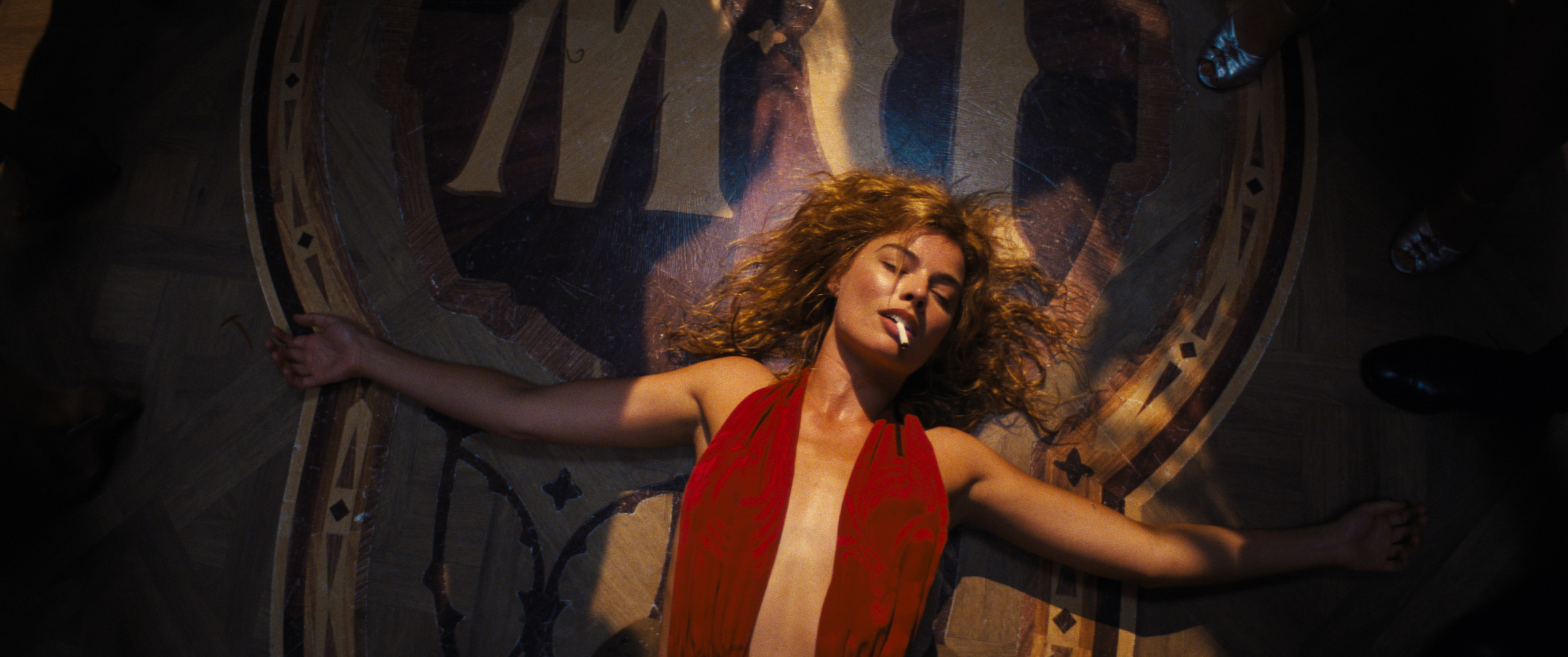What do public orgies, mountains of cocaine, and a party-crashing elephant have in common? They all make an appearance in the first 20 minutes of Damien Chazelle’s new movie Babylon.
In the three-hour-plus Hollywood epic, out Dec. 23, writer-director Chazelle (La La Land, Whiplash) paints a depraved picture of late 1920s Tinseltown—and he wastes no time setting the scene for what’s to come. Before the title card ever appears on screen, a lengthy opening sequence depicting a drug- and sex-fueled rager at a desert mansion introduces the movie’s main players: wide-eyed industry hopeful Manny Torres (Diego Calva), brazen wannabe starlet Nellie LaRoy (Margot Robbie), and seasoned silent-film superstar Jack Conrad (Brad Pitt).
From there, Babylon takes viewers on a rip-roaring ride through the last days of the silent film era. Beginning in 1926 and ending in the early 1930s (with an epilogue set some years later), the movie centers on the industry’s tumultuous transition to talking pictures. But was the Los Angeles of that time period really as uninhibited and debaucherous as Babylon makes it seem?
“I wanted to look under the microscope at the early days of an art form and an industry, when both were still finding their footing,” Chazelle said in commentary included in the film’s production notes. “And, on a deeper level, I liked the idea of looking at a society in change. Hollywood underwent a series of rapid and at times seemingly-cataclysmic changes in the 20’s, and some people survived, but many didn’t. In today’s terms, we’d call it disruption. You look at what these people went through, and it gives you a sense of the human cost that accompanied the kind of ambition that attracted so many people to Los Angeles at that time. There’s a darker side to the story of that transition than I’d seen before.”
Perhaps unsurprisingly, Babylon has been met with polarizing reviews from critics. While some have praised Chazelle for his ambition, others have rebuked the film as over-the-top and tasteless.
“Chazelle thinks he’s created a vision of 1920s Hollywood, but no matter how much research he may have done, he hasn’t listened at all to what these faces, these stories, have told him,” wrote TIME film critic Stephanie Zacharek. “He treats people of this lost era like primitive creatures who just didn’t know any better. He’s not capturing the past; he’s only condescending to it.”
Whatever your take on Babylon, here’s what we know about the complicated history behind the Old Hollywood odyssey.
Read more: Babylon Doesn’t Capture the Magic of Early Hollywood—It Butchers It
The real-life inspirations behind Babylon‘s stars

While the only real person portrayed in Babylon is MGM production head Irving Thalberg (Max Minghella), a number of the movie’s main players do have real-life inspirations.
Robbie’s LaRoy is based on a combination of silent film stars, with the character’s struggles with addiction, difficulty making the transition to “talkies,” and eventual fall from grace hinting at names like Jeanne Eagels, Joan Crawford, and Alma Rubens. But Robbie has said it was the traumatic upbringing of onetime “It Girl” Clara Bow that really helped her understand Nellie.
“Clara Bow had probably the worst childhood of anyone I’ve ever heard of,” Robbie said. “Clara’s parents never got a birth certificate for her because they had already lost two children, and they felt certain she would never make it past her childhood. When I read that, the character of Nellie really started to make sense to me. I could imagine she always felt that every day she was on the planet she was on borrowed time, so she was going for broke every single day.”
On the opposite end of the Old Hollywood fame spectrum is Pitt’s Conrad, an established A-lister who calls to mind big-name stars of the time like John Gilbert, Douglas Fairbanks, and Rudolph Valentino.
“Jack is sort of the uber movie star,” Chazelle said. “He’s the highest grossing leading man in the world when we meet him. He’s one of those guys who has reached the apogee of stardom right at that moment, and the kind of hysterical love and admiration that he inspires, at a moment in time when the whole concept of movie stardom was still relatively new, is really hard for us today to fathom.”
Calva’s Torres, a Mexican immigrant with dreams of making his way up the Hollywood ladder, was also inspired by several real-life figures, according to Chazelle. These included Rene Cardona, who came to Hollywood from Cuba and climbed the studio executive ladder, later playing a role in the Golden Age of Mexican Cinema.
As for some of Babylon‘s more memorable side characters, Chazelle has cited writer Elinor Glyn, reporter Adela Rogers St. Johns, and renowned gossip columnist Louella Parsons as influences for Jean Smart’s Elinor St. John; early female directors like Lois Weber, Dorothy Davenport, and Dorothy Arzner for filmmaker Ruth Adler (played by producer and Chazelle’s wife Olivia Hamilton); and Anna May Wong, the first Asian American film star in Hollywood, as jack-of-all-trades chanteuse Lady Fay Zhu (Li Jun Li).
Finally, charismatic trumpeter Sidney Palmer (Jovan Adepo) is intended to be an amalgam of a myriad of Black stars of the era: talented actors and musicians who had to contend with immense racism in the industry.
“There was a short window of opportunity for Black performers when sound arrived,” Chazelle said, citing musical films of the late ’20s and early ’30s starring Duke Ellington, Louis Armstrong, Ethel Waters, and Bessie Smith as actors who also played music onscreen. Chazelle also lists Curtis Mosby, Les Hite, and Sonny Clay as sources of inspiration for Adepo’s character.
Was early Hollywood really that wild?

Playing off 1952 musical blockbuster Singin’ in the Rain’s lighthearted depiction of late 1920s Hollywood, Babylon clearly seeks to dispel some of the more conservative notions of the silent film era by showcasing a boisterous and thriving party culture, rampant drug abuse, and the often inhumane churn of the movie machine.
“The more I researched those early days of Hollywood, the more I became aware of just how insane that time period was,” Chazelle said. “It was this sort of larger-than-life assemblage of misfits who came together and built a city and a new industry from nothing. I didn’t feel like that kind of crazed behavior had been accurately captured on film before, and I wanted to present their lives and lifestyles in an unvarnished and totally unsanitized way.”
Babylon‘s party scenes are meant to be next-level in order to emphasize the wantoness of the time. The exterior shots of Babylon‘s raucous opening party were filmed at Shea’s Castle, a remote mansion about 60 miles outside of Los Angeles that was built in the 1920s for soirees of that nature. “Socialites used to fly out here and stay for the weekend and do whatever they felt like doing when nobody was watching,” said supervising location manager Chris Baugh.
Another striking sequence late in the movie sends Manny down into the depths of a stomach-churning underground sin den to settle a debt Nellie has racked up with criminal kingpin James McKay (Tobey Maguire). “Welcome to the asshole of Los Angeles,” McKay proclaims as they arrive on the scene.
Babylon‘s production notes explain that the episode was inspired by an incident in Clara Bow’s life as well as the depraved world of Cal-Neva, “an area between the border of California and Nevada that became a hub of gambling in the early 30s as soon as Los Angeles outlawed the practice.”
Babylon doesn’t tell a true story, but instead leans hard into exposing the exploitative history of cinema and how that impacted the society that came up around the industry. However, some of the criticism surrounding the film has centered on Chazelle’s interpretation of this outrageous excess.
“Hollywood was hardly the innocent, asexual industry that a classic like Singin’ in the Rain (or later, The Artist) so lovingly depicted,” wrote Variety‘s Peter Debruge. “But those movies deliver so much more pleasure per frame than this one does, which wears out its welcome in scene after exhausting scene, while purporting to set the record straight.”
Still, others appreciated Chazelle’s commitment to extravagance. “This extensive intro—one of the year’s most impressive feats of filmmaking—feels as exhausting as Chazelle clearly intended it to be,” wrote A.V. Club’s Tomris Laffly of the opening party melee, “serving as a denunciation of a town overflowing with unnamed skeletons concealed by the shadow of those who managed to claim the spotlight.”
More Must-Reads from TIME
- Cybersecurity Experts Are Sounding the Alarm on DOGE
- Meet the 2025 Women of the Year
- The Harsh Truth About Disability Inclusion
- Why Do More Young Adults Have Cancer?
- Colman Domingo Leads With Radical Love
- How to Get Better at Doing Things Alone
- Michelle Zauner Stares Down the Darkness
Write to Megan McCluskey at megan.mccluskey@time.com